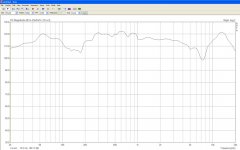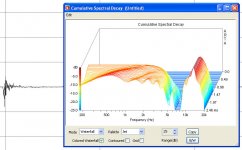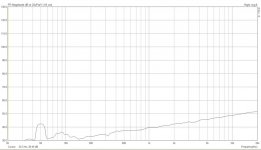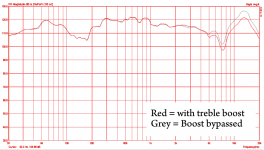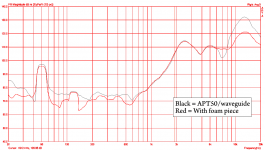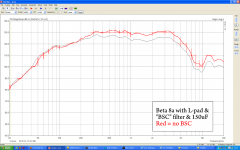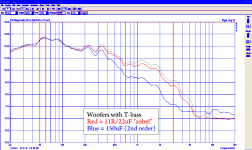Ah yes of course, those waveguides took quite some time to build. Hopefully moving the driver back a bit helps then, I must hear some compression drivers (other than in a PA setup!) some time 🙂
I guess it's the woofers with larger voicecoils (and Xmax) which can produce vent noise, more air pushed through the pole vent. Cone area really is key to good OB bass then.
I guess it's the woofers with larger voicecoils (and Xmax) which can produce vent noise, more air pushed through the pole vent. Cone area really is key to good OB bass then.
If you're ever in the area let me know and we'll arrange a listen. For the money the Eminence compression tweeters seem pretty decent. I'm sure I've not even nearly got everything set optimally and it's already surpassing my old speakers which took many months to get just right.
What you say about woofers sounds very logical. With 3mm xmax there's never going to be much air speed I guess. I'm absolutely sure big cone area is key for good bass in any speaker system 🙂
What you say about woofers sounds very logical. With 3mm xmax there's never going to be much air speed I guess. I'm absolutely sure big cone area is key for good bass in any speaker system 🙂
Hi Simon
Impressive work indeed.
I recently did a tunning job in a friends OB but found it very difficult to reduce the compression tweeter high output. I needed to use an lpad.
Also found that the side pannels affected the woofers performance raising output in the 200Hx area.
Would you please post your final XO so I can compare ideas ?
Regards
Ricardo
Impressive work indeed.
I recently did a tunning job in a friends OB but found it very difficult to reduce the compression tweeter high output. I needed to use an lpad.
Also found that the side pannels affected the woofers performance raising output in the 200Hx area.
Would you please post your final XO so I can compare ideas ?
Regards
Ricardo
Hi Ricardo and thanks for the compliment.
A compression tweeter and/or any PA-style midrange is going to be ear-bleedingly loud compared to hi-fi woofers used on a small open baffle that have been passively equalised for a fairly flat response.
Side panels seem to degrade the performance and cause peaks in the response so I opted for tapered wings to have some low end gain but reduce those audible effects that I cannot even begin to comprehend mathematically (it's probably not just a simple standing wave effect).
That extra bass from 100-200hz or thereabouts can be reduced by line-level EQ or by using Graham Maynard's T-bass circuit that I've made reference to in this thread various times. There's a link in my sig about that circuit. I think, though, that even when using T-bass without crossing the woofers in REALLY low (huge series coil, I use 12mH) there are going to be issues with an annoying droning upper bass response.
There is something not quite right with my response. I'm going to fire up ARTA now and try to find out what that is!
I will be sure to post a final schematic, naturally.
Simon
A compression tweeter and/or any PA-style midrange is going to be ear-bleedingly loud compared to hi-fi woofers used on a small open baffle that have been passively equalised for a fairly flat response.
Side panels seem to degrade the performance and cause peaks in the response so I opted for tapered wings to have some low end gain but reduce those audible effects that I cannot even begin to comprehend mathematically (it's probably not just a simple standing wave effect).
That extra bass from 100-200hz or thereabouts can be reduced by line-level EQ or by using Graham Maynard's T-bass circuit that I've made reference to in this thread various times. There's a link in my sig about that circuit. I think, though, that even when using T-bass without crossing the woofers in REALLY low (huge series coil, I use 12mH) there are going to be issues with an annoying droning upper bass response.
There is something not quite right with my response. I'm going to fire up ARTA now and try to find out what that is!
I will be sure to post a final schematic, naturally.
Simon
Hi Simon
Strangely I came to the same conclusions.
Baffle wings produce a rise in the woofer response near 100-200Hz.
To reduce those I am using 12mH coil and a 2r in series to increase Q of the woofers.
I will read about T-bass now !!!
Can I unscrew the back case of my tweeter so to get lower spl ?
Strangely I came to the same conclusions.
Baffle wings produce a rise in the woofer response near 100-200Hz.
To reduce those I am using 12mH coil and a 2r in series to increase Q of the woofers.
I will read about T-bass now !!!
Can I unscrew the back case of my tweeter so to get lower spl ?
I don't know if that will work. I'd just pad it down with resistors to be honest.
I'm using the pink noise type test on ARTA to get some kind of a response curve about 80cm away from the right speaker, with the other speaker not playing. The method is probably all wrong but already I see a big dip at 7.5khz and a big peak at 13khz. Between 100-250hz I have a dip of about 5-6dB. I think there's my missing midrange warmth, and the healthy response below there goes along with the funky big bass I hear.
If anyone knows of a concise thread or webpage detailing how to get the most from ARTA measuring a speaker I'd love to see it. I feel I could be getting more accurate results if I wasn't just "messing around".
I'm using the pink noise type test on ARTA to get some kind of a response curve about 80cm away from the right speaker, with the other speaker not playing. The method is probably all wrong but already I see a big dip at 7.5khz and a big peak at 13khz. Between 100-250hz I have a dip of about 5-6dB. I think there's my missing midrange warmth, and the healthy response below there goes along with the funky big bass I hear.
If anyone knows of a concise thread or webpage detailing how to get the most from ARTA measuring a speaker I'd love to see it. I feel I could be getting more accurate results if I wasn't just "messing around".
Quick question if anyone will bite - what would a treble boost filter do to the phase of a tweeter? I ask because my top end dip looks like it might be related to an out of phase thing happening with the Beta 8a. Perhaps I should get rid of that bit and see what I can do at getting the axial response smooth at the crossover region instead.
I love this part of the "design process" (to make messing around sound grand) 😀
I love this part of the "design process" (to make messing around sound grand) 😀
The dip and peak on 7.5k and 13k might probably be the throat problem. APT itself should be quite smooth in its own range - if a little bit roll-off at the very top end.
Interesting thoughts, which hadn't even crossed my mind.
Here's what I'm seeing. I tried at different distances and the top of the graph is always about the same so I'm going to put some faith in it and say it's not completely random noise 🙂
*I've added a graph of the noise ARTA sees with the mic pre-amp switched off for reference.
Here's what I'm seeing. I tried at different distances and the top of the graph is always about the same so I'm going to put some faith in it and say it's not completely random noise 🙂
*I've added a graph of the noise ARTA sees with the mic pre-amp switched off for reference.
Attachments
Last edited:
Here's an overlay showing the "treble boost" filter on or shorted out. Clearly it wasn't doing anything useful: it just looks to be cutting everything equally. I'll pad the tweeter down some more and adjust its x-o point and see what happens.
Attachments
Looks like I need to get on and make a spacer to put the end of the APT-50's own phase plug in line with the start of the waveguide's throat...
Tweeter with just a 3.3uF cap and L-pad.
So you have a similar problem... the tweeter is too loud.
Would you post a graph without the tweeter connected ?
IMO, the midrange is the most important driver so you could try leveling it with the woofers in the first place.... than you can connect the tweeter and smooth things out.
Also I agree that the tweeter moth is protruding from the horn.... maybe it should be flushed in.
More graphs will follow today. I'm just attaching some foam to act as a low-pass filter on the tweeter to soak up that resonant peak at 14khz.
edit: here's the before and after from adding a strip of foam across the tweeter. 10dB of reduction where it's needed and as a bonus it seems to have filled in the preceding dip!
edit: here's the before and after from adding a strip of foam across the tweeter. 10dB of reduction where it's needed and as a bonus it seems to have filled in the preceding dip!
Attachments
Last edited:
Here's the mid driver in isolation with and without the baffle step correction filter. The driver also has an L-pad for attenuation and a 150uF cap for high-pass filtering. There's no low-pass filter as such here (other than a zobel network of 10uF/10R)
Attachments
Last edited:
Here's the woofer with T-bass and a 12mH ferrite coil in series. Also showing with a zobel network and with a 150uF cap as a 2nd pole (no zobel). I tried with zobel and 2nd order together but it made the picture messy: essentially it looked as with 150uF (2nd order) but with a bit less output after about 2khz.
Attachments
The CSD you posted on the last page is a little weird. At 0 ms, the response should look approximately like the FR graph. And then the stored energy appears as a waterfall. Check the impulse gating. I think the gate must start before the begining of the impulse response.
The woofer and mid looks nice. If you don't have any nasty resonances in the 2k-5k region from the mid then that's great. I am also interested in how you tackle that 14khz hump in the tweeter response.
Great work. Keep going!
The woofer and mid looks nice. If you don't have any nasty resonances in the 2k-5k region from the mid then that's great. I am also interested in how you tackle that 14khz hump in the tweeter response.
Great work. Keep going!
Last edited:
Here's the mid driver in isolation with and without the baffle step correction filter. The driver also has an L-pad for attenuation and a 150uF cap for high-pass filtering. There's no low-pass filter as such here (other than a zobel network of 10uF/10R)
Red curve looks good.
What is the XO on the tweeter ?
ra7, thanks for pointing that out, I am still puzzled by the CSD plot though. I'm not sure how I change the gating as I don't see that terminology used in the options so far. I'm playing around with the setup now trying different things but I'm shooting in the dark a little bit.
Ricardo, the XO on the tweeter is currently 2.5R/3.9R (parallel/series) L-pad at the terminals, preceded by 2.2uF in series and 0.22mH in parallel. There is an inch or so of foam in front of the tweeter at the centre of the waveguide.
I have opted to keep 2nd order on the bass for now but I find it makes the bass less integrated and it stands out on some notes. To help I've added a 2.7R resistor in series with the cap to calm its effects down a bit.
I've recorded smoother overall plots than I showed at the start of the day but I still have a bit of a dip 100-200hz and funny things happening at the top end!
Ricardo, the XO on the tweeter is currently 2.5R/3.9R (parallel/series) L-pad at the terminals, preceded by 2.2uF in series and 0.22mH in parallel. There is an inch or so of foam in front of the tweeter at the centre of the waveguide.
I have opted to keep 2nd order on the bass for now but I find it makes the bass less integrated and it stands out on some notes. To help I've added a 2.7R resistor in series with the cap to calm its effects down a bit.
I've recorded smoother overall plots than I showed at the start of the day but I still have a bit of a dip 100-200hz and funny things happening at the top end!
I'm going to have to read up on how to adjust the T-bass circuit as I need a little less boost from it and a little less cut in the upper bass too from the looks (and sounds) of things.
- Status
- Not open for further replies.
- Home
- Loudspeakers
- Multi-Way
- 3 way open baffle with Eminence and Skytronic
